
Dropping in briefly to wish everyone compliments of the Season and a happy, peaceful, prosperous New Year. The photo is of one of my support team revelling in last year's cold snap and making doggy snow angels on the back lawn.
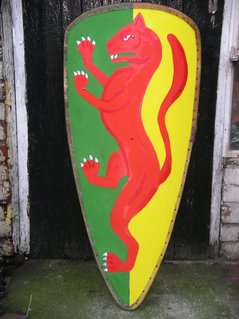 I have to share a recent amusing moment.
I have to share a recent amusing moment. Although I'm still working on the story of John Marshal - A Place Beyond Courage, I am also looking towards the next project which I'm due to start writing byn March 07. As usual there's no title yet, but I do know it's going to be about Roger Bigod, William Marshal's eldest grandson and will cover much of the reign of Henry III.
Although I'm still working on the story of John Marshal - A Place Beyond Courage, I am also looking towards the next project which I'm due to start writing byn March 07. As usual there's no title yet, but I do know it's going to be about Roger Bigod, William Marshal's eldest grandson and will cover much of the reign of Henry III.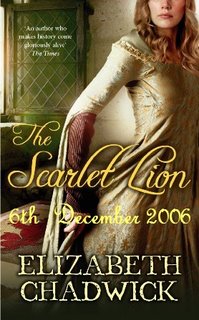 I have a piece to write about another visit I made to the Temple Church last week and how it pertains to Gilbert Marshal, it's just a case of getting around to it as Christmas and approaching deadlines, begin to squeeze my time even more than it's usually squeezed.
I have a piece to write about another visit I made to the Temple Church last week and how it pertains to Gilbert Marshal, it's just a case of getting around to it as Christmas and approaching deadlines, begin to squeeze my time even more than it's usually squeezed.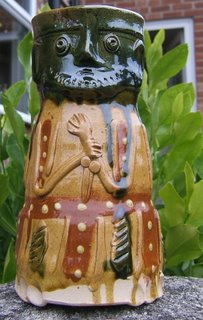 Staying on the theme of re-enactment for this next post, I went to two re-enactor's markets in Warwick and Coventry last weekend and returned with all sorts of gauds! The rather alarming piece of pottery on the left is a replica of a mid thirteenth century jug from Kingston on Thames. It's made by 'Jim the Pot' of Trinity Court Potteries, whose wares may also be seen gracing the trestles of the film A Knight's Tale. Here's the url to his site. www.trinitycourtpotteries.co.uk
Staying on the theme of re-enactment for this next post, I went to two re-enactor's markets in Warwick and Coventry last weekend and returned with all sorts of gauds! The rather alarming piece of pottery on the left is a replica of a mid thirteenth century jug from Kingston on Thames. It's made by 'Jim the Pot' of Trinity Court Potteries, whose wares may also be seen gracing the trestles of the film A Knight's Tale. Here's the url to his site. www.trinitycourtpotteries.co.uk Last weekend Nottingham held its fourteenth annual Robin Hood Pageant in the castle grounds. It was business as usual for my re-enactment society Regia Anglorum who were employed to provide part of the living history exhibit and acts of derring do in the main arena.
Last weekend Nottingham held its fourteenth annual Robin Hood Pageant in the castle grounds. It was business as usual for my re-enactment society Regia Anglorum who were employed to provide part of the living history exhibit and acts of derring do in the main arena. Every year the All About Romance website http://www.likesbooks.com/
Every year the All About Romance website http://www.likesbooks.com/ I probably receive about a dozen e-mails a week from readers. It's always lovely to hear from people, as well as interesting to know a little bit about them. It helps with the demographic of who my audience is, but I'm also generally a curious person about life, the world and everything, so it's good too to have some feedback and interraction.
I probably receive about a dozen e-mails a week from readers. It's always lovely to hear from people, as well as interesting to know a little bit about them. It helps with the demographic of who my audience is, but I'm also generally a curious person about life, the world and everything, so it's good too to have some feedback and interraction. This is a photo of one of the rooms in the library where I borrow most of the books I read. It's called Bromley House Library and it stands smack bang in Nottingham's busy city centre. You'd never guess it was there from the outside. The ground floor entrance way is bracketed by two shops that pay rent to the library for the premises. The library itself is situated on the floors above, but has a ground floor back entrance to a wonderful 'secret' garden.The library is a grade II listed building, originally built in 1752, and has been a library since 1822.
This is a photo of one of the rooms in the library where I borrow most of the books I read. It's called Bromley House Library and it stands smack bang in Nottingham's busy city centre. You'd never guess it was there from the outside. The ground floor entrance way is bracketed by two shops that pay rent to the library for the premises. The library itself is situated on the floors above, but has a ground floor back entrance to a wonderful 'secret' garden.The library is a grade II listed building, originally built in 1752, and has been a library since 1822. I'm dropping by on the run as life continues at a hectic pace, but I just wanted to post the fabulous cover for The Scarlet Lion, due out in hardcover in December. It hasn't been without its traumas. An earlier cover draft was scrapped due to a hissy fit by me the author who felt that putting a sulky teenage heroine on the front, admiring her party dress was not a good representation of the powerful, mature Isabelle de Clare, wife, helpmeet and consort of the great William Marshal.
I'm dropping by on the run as life continues at a hectic pace, but I just wanted to post the fabulous cover for The Scarlet Lion, due out in hardcover in December. It hasn't been without its traumas. An earlier cover draft was scrapped due to a hissy fit by me the author who felt that putting a sulky teenage heroine on the front, admiring her party dress was not a good representation of the powerful, mature Isabelle de Clare, wife, helpmeet and consort of the great William Marshal.


I know John Marshal and his father fought a duel over the Marshalsea. Checking my notes, I see it was against William de Hastings and Robert de Venoiz. De Venoiz’s father had once been a Marshal – Geoffrey the Marshal. Dare one think noses had been put out of joint?
My Friend: Puffing and panting in panic or exertion. I’m with the father. It’s a big thing for a man of his age to do. He’s pleased his son is a healthy young man. All the lessons, all the training have been worthwhile. He’s got a helmet on and he’s looking around. There are rows of people watching and a fence in front of them. He’s taking a mouthful of liquid – it’s water – and just spitting it out. John is there. He’s a lot cooler than his father about this. He knows he has to protect his father and keep his father behind him. The other people have got a different sort of armour on. It’s burnished and bronzey while John’s and his father’s is that blackened silver colour. I’m with John now. He’s sizing up the field and his tactics. He thinks he’ll go for the older man, head him off and finish him quickly because he’s the better fighter, and then he can run round and get the younger man. If the younger man goes for his father, his father’s bulk will be able to hold him off until John can get to him. John acts as if he’s still nonchalantly taking a break, but then he suddenly turns round and with a roar, attacks. The other two are taken by surprise by the swiftness of John’s assault. They think he’s going for the younger man, but he crosses over in front of the older one. He’s using a morning star flail in one hand and a dagger in the other – he’s going all or nothing for this. If he’s going to protect his father he’s got to fight for two of them. He’s using the morning star and he’s wrapped the chain round the older man’s neck. It’s not a killing blow, but it’s enough to bring him down, choking him and wounding his neck. He might not be dead but he’s out of the fight. The younger one has been stopped in his tracks by what John’s done and the sight of the older, better fighter down. It’s what John wanted. Now John gets out his sword and challenges the younger man. The younger man is swallowing after what he’s just seen. He’s a bit reluctant to take on John. He wanted the easier job of John’s dad. He has to face John….and he’s not doing it. He’s put his sword down – yes, he’s put his sword down. John is saying ‘Come on then, you coward, come on. He pokes him with his own sword. The other won’t rise to the challenge. The wounded man is being carried off the battlefield – it looks like a horse schooling field. The young man looks at all of this, seeing the odds. He keeps his sword down. The crowd are a bit disappointed. They’re shouting ‘Go on!’
John is so contemptuous that he turns half a shoulder to the other man and then fully turns his back just to show utter contempt. Then he suddenly whips round and shakes the blade at the other man in threat. This makes the challenger look even more stupid and the crowd starts laughing. John goes up to his father, puts his arm round him and they walk off the field to cheers, their position in the Marshalsea confirmed in public.
Stirring stuff eh?
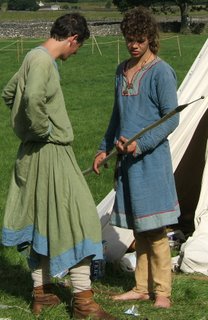 I spent the last weekend with the members of Regia Anglorum at Castleton helping to put on a show to the public at Peverel Castle, Castleton, Derbyshire, dateline 1080. I managed to grab a few snapshots before we opened to the public (taking photos whilst in kit is forbidden as it detracts from the authenticity...although I did sneak one of Lord William Peverel performing on his destrier!). To the left are a pair of squires preparing to limber up.
I spent the last weekend with the members of Regia Anglorum at Castleton helping to put on a show to the public at Peverel Castle, Castleton, Derbyshire, dateline 1080. I managed to grab a few snapshots before we opened to the public (taking photos whilst in kit is forbidden as it detracts from the authenticity...although I did sneak one of Lord William Peverel performing on his destrier!). To the left are a pair of squires preparing to limber up.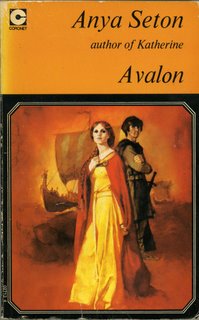
 Last Thursday I went along to my monthly meeting with fellow members of the Nottingham branch of Regia Anglorum www.regia.org
Last Thursday I went along to my monthly meeting with fellow members of the Nottingham branch of Regia Anglorum www.regia.org
 While I wait to see how my novel about William Marshal - The Greatest Knight is performing in paperback in the bookshops, I have continued to work on the story of the above's father, John Marshal. Working on the research is proving both fascinating and frustrating as witnessed by my attempts to get the facts about the Wherwell Abbey incident straight.
While I wait to see how my novel about William Marshal - The Greatest Knight is performing in paperback in the bookshops, I have continued to work on the story of the above's father, John Marshal. Working on the research is proving both fascinating and frustrating as witnessed by my attempts to get the facts about the Wherwell Abbey incident straight.
 I am going to be absent for a few days, researching in Wiltshire, so in the interim, thought I'd post a photo of a couple of members of my backup team during an off duty moment. I'm not sure what my husband Roger was reading at the time I posted the photo, but obviously something engrossing. Our dog Taz decided to join him and take the weight off his paws.
I am going to be absent for a few days, researching in Wiltshire, so in the interim, thought I'd post a photo of a couple of members of my backup team during an off duty moment. I'm not sure what my husband Roger was reading at the time I posted the photo, but obviously something engrossing. Our dog Taz decided to join him and take the weight off his paws.
 Just dropping by to say that I have had a reply from the Master of the Temple Church, the Reverend Robin Griffith-Jones.
Just dropping by to say that I have had a reply from the Master of the Temple Church, the Reverend Robin Griffith-Jones. I'm late with my next blog because I've been away in London for the day, visiting my editors Joanne Dickinson and Barbara Daniel at Little Brown. Our lunch, with my agent Carole Blake, was partly business and partly social and altogether enjoyable. Little Brown's offices are right on Waterloo Bridge and not far from The Temple Church. Since May 19th was the anniversary of William Marshal's burial there, and thus fairly close, I took some time out to honour him and lay a posy on his breast... or on his effigy's breast. No one knows whereabouts his remains are now, as they were moved some years after his burial, and the church has suffered bomb damage too. Suffice to say that his presence remains somewhere in the precincts. The posy was just three simple flowers and a bit of foliage, but I chose his colours - green, yellow and red, and made a donation to the church in his honour.
I'm late with my next blog because I've been away in London for the day, visiting my editors Joanne Dickinson and Barbara Daniel at Little Brown. Our lunch, with my agent Carole Blake, was partly business and partly social and altogether enjoyable. Little Brown's offices are right on Waterloo Bridge and not far from The Temple Church. Since May 19th was the anniversary of William Marshal's burial there, and thus fairly close, I took some time out to honour him and lay a posy on his breast... or on his effigy's breast. No one knows whereabouts his remains are now, as they were moved some years after his burial, and the church has suffered bomb damage too. Suffice to say that his presence remains somewhere in the precincts. The posy was just three simple flowers and a bit of foliage, but I chose his colours - green, yellow and red, and made a donation to the church in his honour.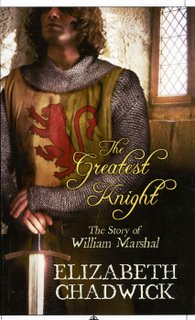 An important part of the creative process for me as a writer is the use of music. I don't actually listen to it while I'm writing, but while I'm away from the PC doing mundane jobs, I will listen to tracks which I think suit the situations and the emotional resonances of my characters. I use music to build moods and motivations, to inspire and help me understand. This particular trait has been with me ever since I started writing stories down. Long before films and adverts were using popular music to sell their product, I was visualising my novels to a soundtrack. Indeed, I didn't know whether to be delighted or miffed when the film A Knight's Tale came out with a rock soundtrack - cos I wuz there first!
An important part of the creative process for me as a writer is the use of music. I don't actually listen to it while I'm writing, but while I'm away from the PC doing mundane jobs, I will listen to tracks which I think suit the situations and the emotional resonances of my characters. I use music to build moods and motivations, to inspire and help me understand. This particular trait has been with me ever since I started writing stories down. Long before films and adverts were using popular music to sell their product, I was visualising my novels to a soundtrack. Indeed, I didn't know whether to be delighted or miffed when the film A Knight's Tale came out with a rock soundtrack - cos I wuz there first!All the tracks have had their part to play, but some have been there from almost the beginning and have had a more major role. Stand out tracks for me creatively have been Rufus Wainwright’s Hallelujah and very strongly Don Henley’s rendering of the Cohen written Everybody Knows, which was just so appropriate on so many levels. Billy Joel’s All About Soul and Evanescence’s Bring Me to Life were very useful for defining the relationship between William and his wife, Isabelle de Clare. See what you think!
Relax – Frankie Goes to
Fight – No Vacancy. From the album
Fell on Hard Times – Neal Casal. From the album Anytime Tomorrow. William is forced to sell his cloak to buy a horse. I loved the fact that Casal sings as part of the lyrics ‘I sold my green leather jacket,’ because it’s a direct link to William having to sell his cloak.
Goddess in the Doorway – Mick Jagger. From the album Goddess in the Doorway. William first sets his eyes on Eleanor of Aquitaine and he’s captured for life!
She’s Always A Woman – Billy Joel. From the album Ultimate Collection. More of Eleanor of Aquitaine, not just as William sees her but as others do too.
I want it all – Queen. From the album Greatest Hits. Again used in THE CHAMPION. This partly refers to William, but mostly to the Young King, who does ‘want it all.’
Would you – Touch & Go. Clara’s propositioning of William! Definitely a fun number. I don’t even particularly like this song, but it just so suits the incident!
Addicted to Love – Robert Palmer. From the Album Addictions. More like addicted to lust! The first rush between Clara and William.
What About Love – Heart. From the Album Greatest Hits. Clara isn’t getting all she wants from the relationship.
You’re So Vain – Carly Simon. From the compilation album The Story and the Song. This and the next one are all about The Young King and his inflated ego.
That Don’t Impress Me much – Shania Twain from the album Come on Over. Definitely sums up The Young King. Yes, he had the brains, the looks, the kit, ‘You think you’re cool, but have you got the touch?’
Halleluljah – Rufus Wainwright. From the album soundtrack to Shrek. This is an all purpose powerful, poignant, tears to the eyes sad song to cover the themes of Clara’s leaving, the death of the Young King and the loss of William’s youthful optimism and innocence. Hard to know where to put it in the soundtrack as it could have gone in several places.
Disc 2
Don’t Speak – No Doubt. Single. The end of the relationship between William and Marguerite seen from her viewpoint
Everybody Knows – Don Henley. From the album
Over The Hills And Far Away – Nightwish. Traditional song rendered in Nightwish’s inimitable style. This was in the soundtrack early on for William’s supposed adultery with the Young Queen. Not all the lyrics fit now, but it still conveys some of the underlying emotions, and I love it!
These Dreams – Heart. From the album Greatest Hits. Isabelle dreaming at the Tower when William comes for Heloise
God Gave me Everything – Mick Jagger. From the album Goddess in the Doorway. William has everything. Lands, prestige, power, a lovely young wife, and an heir.
 The 'Deity' as she is very fondly known by the members of the e-lists she owns, also goes by the name of Wendy Zollo. She not only runs my Yahoo reader list but is one of my best friends on the internet. I'm on the left, Wendy's on the right.
The 'Deity' as she is very fondly known by the members of the e-lists she owns, also goes by the name of Wendy Zollo. She not only runs my Yahoo reader list but is one of my best friends on the internet. I'm on the left, Wendy's on the right.